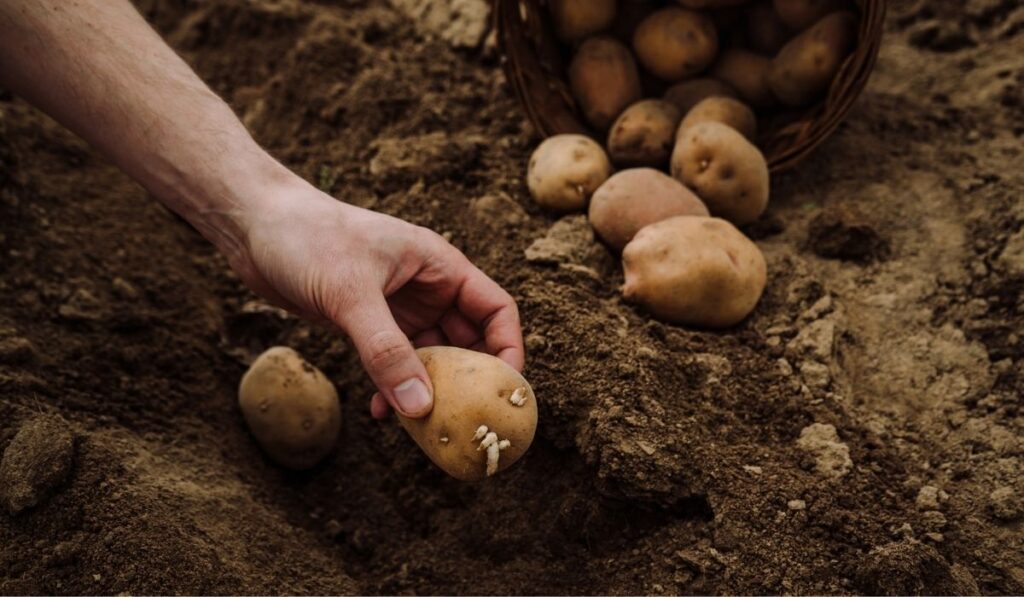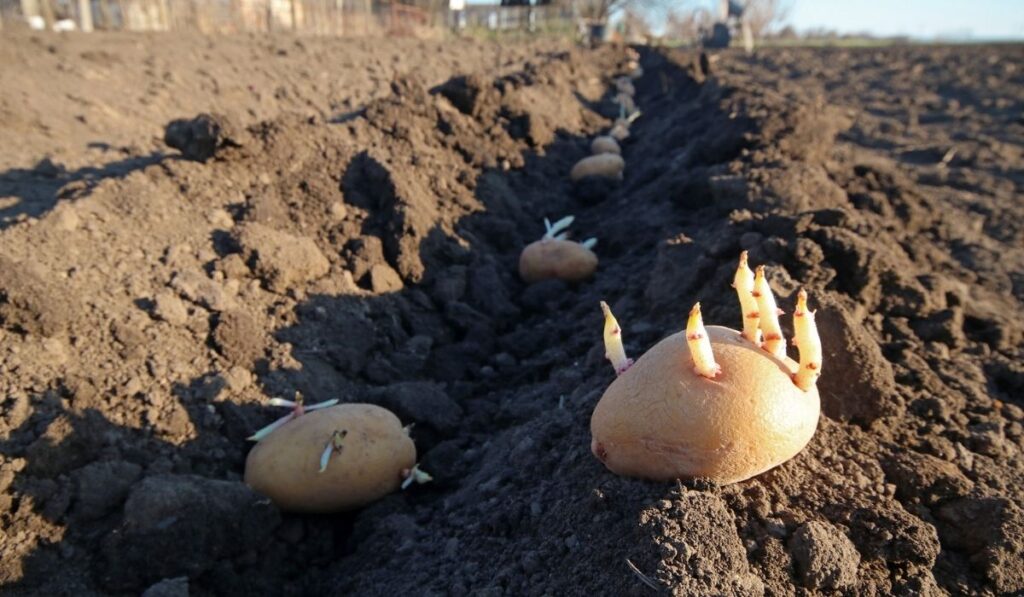The texture and taste of homegrown potatoes are vastly superior to those of store-bought ones, especially if you plant the early types. Whether you want to have healthy sides or hearty meals, it’s always great to have potatoes growing in your garden, so that you can bake, roast, mash, and fry them to your heart’s content. But when should you plant your potatoes ?
It’s best to plant potatoes in early spring, about two or three weeks before your state’s last frost date. You can plant seed potatoes straight in the ground or in a bed of straw to start. Just make sure you mulch the soil and give the plants plenty of water, an equivalent of 1-2in of rainfall/wk.
Now that you’ve seen how easy it is to grow America’s favorite vegetable, let’s take a closer look at exactly how to plant potatoes, which month is best for the planting process, how long they take to grow, and how you should take care of the plants.
How Do You Grow Potatoes?

You can grow potatoes by planting seed potatoes in the soil. However, the term ‘seed potatoes’ can be a bit confusing. It’s important to note that they’re not actually seeds, but rather whole potatoes that are grown for the sole purpose of replanting and producing potato crops.
While potato seeds do exist, they’re rarely used. That’s why you’ll be hard-pressed to find any potato seed packets for sale. Options like these seed potato packs (on Amazon) enable you to add some variety if you want at this step, too.
So, in order to grow potatoes, you just need to place a mature seed potato into the ground. You can either plant the whole vegetable or cut it up into pieces, so that there are only one or two eyes or buds on each piece.
Keep in mind that seed potatoes are very different from the ones you buy at your local grocery store. Most store-bought potatoes are treated with a sprout inhibitor, which prevents them from developing eyes. You can’t grow a potato plant with an eye-less potato, so make sure you only choose a disease-free seed potato.
There are several ways you can plant a seed potato:
Straight Into the Ground
Large potato plantings are usually grown this way. If you’re placing your seed potatoes in the ground, plant them one inch deep into the soil.
Tires
Many gardeners grow their potatoes in tires. Fill up a tire with soil and place your seed potatoes into it. Once the plant gets bigger, stack a few more tires on top of the original one and fill those up with soil as well.
Straw
Planting potatoes in straw might seem unusual, but it’s actually very effective. Simply lay out a bed of straw and place the seed potatoes in it. Once the plants start growing, cover them with an additional layer of straw.
Additional Planting Tips
- Around two days before planting, use a sharp paring knife to chop large seed potatoes into small, golf ball-sized pieces. It’s best to have one to two eyes on each piece. This extra time enables the pieces to form a protective covering over their cut surface, improving their rot resistance and moisture retention abilities.
- Don’t cut seed potatoes that are already smaller than an egg; just plant them whole.
- It’s best to plant potatoes in rows around three feet apart. Use a round-point shovel (on Amazon) or a hoe (also on Amazon) to dig a trench row approximately eight inches deep and six inches wide, tapering the bottom to around three inches wide. Mix in leaves, compost, or aged manure.
- In every trench, place the potato pieces with the cut side facing down and space them around 12 to 14 inches apart. Cover the pieces with three to four inches of soil.
- Once you see sprouts, use a hoe to add another three to four inches of soil into the trench, leaving only a couple of inches of your plants exposed. Repeat the process as they grow, until the trench reaches ground level.
- Add mulch between the rows to control weeds, conserve moisture, and lower the moisture of the soil.
Which Months Are Best for Planting Potatoes?
Potatoes are cool weather vegetables, so it’s better to plant them in early spring. For best results, plant your potatoes two or three weeks before the last frost date.
However, keep in mind that early seed potatoes can be ruined if they’re placed in soil that’s too wet. For this reason, it’s better to use the soil rather than the calendar to determine the right planting time.
Don’t plant your potatoes in wet soil that sticks together or is difficult to work. Let the soil dry out a bit and then start the planting process. If you have a wet or late spring, plant your potatoes a bit later — in April or even as late as June, especially if you’re planting in containers.
If you live in a warmer climate, you can plant your potatoes any time between September and February. If you live in a state with relatively mild winters, you can plant the vegetable in September.
For instance, it’s best to plant potatoes in January in Central Florida, while in Georgia, it’s best to start the planting process in February.
How Long Does It Take to Grow Potatoes?
It’s important to note that different potato types have different DTMs (days to maturity). However, new potatoes generally take 60 days to grow, while potato varieties with large tubers become ready to harvest after 90 days.
Instead of digging up all your potatoes at the same time, it’s best to dig up a test hill first to see whether the vegetable is ready to harvest. Mature potatoes have a thick skin that’s tightly attached to the flesh.
On the other hand, new potatoes have a thin skin that rubs off easily. If your tubers are still too new, it’s better to leave them in the ground for a couple more days.
How to Care for Potato Plants

Potatoes are mostly fuss-free and easy to grow. Just make sure you maintain even moisture, particularly after the flowers start to bloom. It’s best to give them around one to two inches of water every week.
But make sure you don’t give them too much or too little water right after planting, as it could cause their form to misshapen. Also, stop watering once the foliage starts to turn yellow and dies off.
Hilling Potatoes
You can improve and enhance potato flavor with darkness and depth. Once the plants grow above the surface of the soil, periodically mound up or “hill up” compost and soil around the plant, leaving only the top leaves uncovered.
Make sure you don’t expose any of the potato spuds to the sunlight, as this could turn them green and give them a bitter taste.
Here are a few more tips for hilling potatoes:
- It’s best to mound up soil in the morning when the plants are tallest.
- Use a hoe to cover the base of the plant and the tubers with soil.
- Stop hilling once the plant reaches six inches tall and before it starts to bloom.
